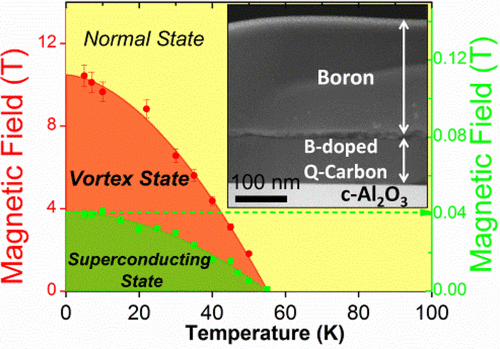Our official English website, www.x-mol.net, welcomes your
feedback! (Note: you will need to create a separate account there.)
Discovery of High-Temperature Superconductivity (Tc = 55 K) in B-Doped Q-Carbon
ACS Nano ( IF 15.8 ) Pub Date : 2017-11-10 00:00:00 , DOI: 10.1021/acsnano.7b06888 Anagh Bhaumik 1 , Ritesh Sachan 1, 2 , Siddharth Gupta 1 , Jagdish Narayan 1
ACS Nano ( IF 15.8 ) Pub Date : 2017-11-10 00:00:00 , DOI: 10.1021/acsnano.7b06888 Anagh Bhaumik 1 , Ritesh Sachan 1, 2 , Siddharth Gupta 1 , Jagdish Narayan 1
Affiliation

|
We have achieved a superconducting transition temperature (Tc) of 55 K in 27 at% B-doped Q-carbon. This value represents a significant improvement over previously reported Tc of 36 K in B-doped Q-carbon and is the highest Tc for conventional BCS (Bardeen–Cooper–Schrieffer) superconductivity in bulk carbon-based materials. The B-doped Q-carbon exhibits type-II superconducting characteristics with Hc2(0) ∼ 10.4 T, consistent with the BCS formalism. The B-doped Q-carbon is formed by nanosecond laser melting of B/C multilayered films in a super undercooled state and subsequent quenching. It is determined that ∼67% of the total boron exists with carbon in a sp3 hybridized state, which is responsible for the substantially enhanced Tc. Through the study of the vibrational modes, we deduce that higher density of states near the Fermi level and moderate to strong electron–phonon coupling lead to a high Tc of 55 K. With these results, we establish that heavy B doping in Q-carbon is the pathway for achieving high-temperature superconductivity.
中文翻译:

B掺杂Q碳中高温超导(T c = 55 K)的发现
我们已经在27at%的B掺杂Q碳中实现了55 K的超导转变温度(T c)。该值表示比先前报道的B掺杂Q碳中的36 K的T c显着提高,并且是散装碳基材料中常规BCS(Bardeen-Cooper-Schrieffer)超导性的最高T c。掺B的Q碳具有H c2(0)〜10.4 T的II型超导特性,这与BCS形式主义一致。B掺杂的Q碳是通过B / C多层膜的纳秒激光熔融过冷而形成的,然后进行淬火。经确定,sp 3中约有67%的硼与碳一起存在杂化状态,这是导致T c显着提高的原因。通过对振动模态的研究,我们得出结论,费米能级附近较高的态密度以及中等至强的电子-声子耦合会导致55 K的高T c。根据这些结果,我们得出结论,Q-碳是实现高温超导的途径。
更新日期:2017-11-11
中文翻译:

B掺杂Q碳中高温超导(T c = 55 K)的发现
我们已经在27at%的B掺杂Q碳中实现了55 K的超导转变温度(T c)。该值表示比先前报道的B掺杂Q碳中的36 K的T c显着提高,并且是散装碳基材料中常规BCS(Bardeen-Cooper-Schrieffer)超导性的最高T c。掺B的Q碳具有H c2(0)〜10.4 T的II型超导特性,这与BCS形式主义一致。B掺杂的Q碳是通过B / C多层膜的纳秒激光熔融过冷而形成的,然后进行淬火。经确定,sp 3中约有67%的硼与碳一起存在杂化状态,这是导致T c显着提高的原因。通过对振动模态的研究,我们得出结论,费米能级附近较高的态密度以及中等至强的电子-声子耦合会导致55 K的高T c。根据这些结果,我们得出结论,Q-碳是实现高温超导的途径。











































 京公网安备 11010802027423号
京公网安备 11010802027423号